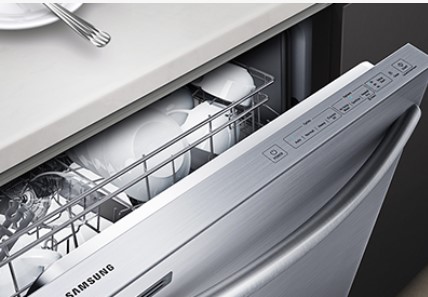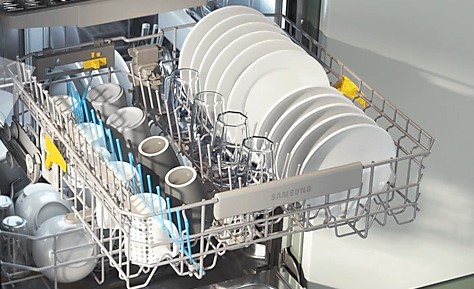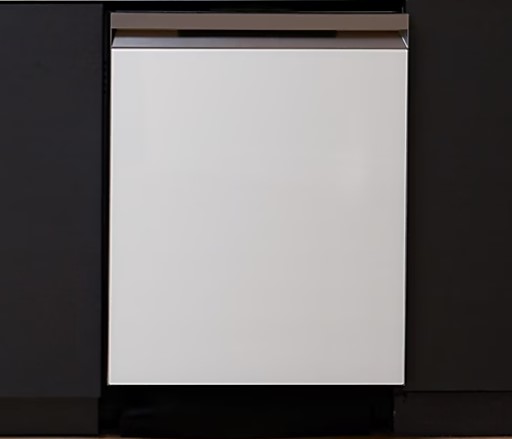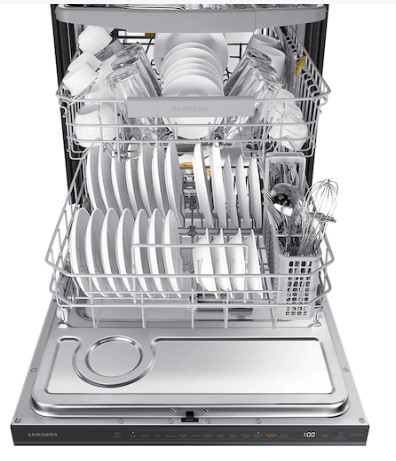Samsung dishwashers employ the most advanced dish-drying technology, and so you don’t expect the dishes to come out wet after a rinse cycle. But what if that’s the case? What could explain your Samsung dishwasher not drying dishes?
Your Samsung dishwasher isn’t drying dishes because of a wrong cycle or setting, inadequate rinse aid, improper dish loading, wrong water temperature, poor airflow, an error code, blocked vent, or component failure.
And while touching on component failure, it could be the turbidity sensor, heating element, or fan motor at fault. So, you probably will need to check all three dishwasher components once you rule out the first seven reasons.
The good thing about this troubleshooting is that you don’t necessarily need an expert. You can do everything from the diagnosis to fixing, and I’ll help you.
Let’s jump in!

In a hurry? Check out the eight issues responsible for a non-drying Samsung dishwasher in the troubleshooting guide below.
Samsung Dishwasher Not Drying Completely – Quick Troubleshooting Guide
| – | Likely Cause | Quick Fix |
| 1. | Wrong Cycle or Setting | Choose the correct dish-drying cycle, preferably Heated Dry, Dry+, High Temp, Sanitize, or any other. |
| 2. | Inadequate Rinse Aid | Add Rinse Aid if the Rinse Refill indicator is on |
| 3. | Improper Dish Loading | Re-load the dishes properly. |
| 4. | Wrong Water Temperature | Raise the water temperature to 1200F-1490F |
| 5. | Poor Airflow | Open the dishwasher door by a ½ inch within an hour of completing the cycle to improve airflow. |
| 6. | Error Code | Tightly latch the door and restart the dishwasher. Check the error code meaning online if it doesn’t clear. |
| 7. | Blocked Vent | Clear any blockage from the vent. |
| 8. | Component Failure | Replace the turbidity sensor, heating element, or fan motor if faulty. |
Why Is My Samsung Dishwasher Not Drying Dishes?
Your Samsung dishwasher won’t dry for different reasons, and below are 8 of the most common and their quick fixes:
1. Wrong Cycle or Setting
Not all settings promote drying. Some cycles and settings will leave the dishes wet, which could be why your Samsung dishwasher doesn’t dry the dishes. Thus, checking what setting or cycle you are using is essential to ensure it is drying-tailored.
Fix
Consider using any of the drying-tailored dishwasher cycles/settings. That includes Heated Dry (which uses a heater to use dry the dishes), Dry+ (which raises the water temperature for improved drying), High Temp Wash (which uses hot water all through), and Sanitize (which increases the water temperature just like Dry+).
2. Inadequate Rinse Aid
Rinse Aid lowers the water surface tension, causing it to cool down (condense), drip, and eventually evaporate. In that case, it’s instrumental for the drying performance of the dishwasher.
Overall, the higher the dish load, the more the Rinse Aid. So, it could be that the Rinse Aid is not enough for the number of dishes you are trying to wash and dry. Overall, you can know if the level has dropped if the Rinse Refill indicator lights up.
Fix
Check the Rinse Refill indicator to see if it’s on, and if yes, then you should refill the Rinse Aid.
3. Improper Dish Loading
The dishes should be loaded appropriately to allow water to drip off and encourage dish drying. If the dishes are poorly stacked, that won’t happen, and you’ll most likely end up with improperly cleaned and wet dishes.
Fix
Stop the dishwasher and re-load the dishes properly. Ensure you don’t stack them too closely to stop the water from dripping off.

4. Wrong Water Temperature
A Samsung dishwasher cleans better with hot water and dries better. The dishwashing water should be about 1200F-1490F for better cleaning and dish drying.
If it’s lower than 1200F, it’s highly likely that the dishwasher won’t just fail to clean the dishes properly but will also fail to dry them.
Fix
Check the dishwasher cleaning water’s temperature and adjust it to 1200F-1490F if that’s not the case.
5. Poor Airflow
It’s necessary to open the dishwasher door slightly (about ½ inch) within an hour of completing the cycle. The reason is to encourage good airflow into the dishwasher, which aids in drying the dishes.
So, if you haven’t done that, then that could be the reason the dishes are still wet.
Fix
Consider opening the dishwasher door slightly (by ½ inch) within the first hour of completing the dishwashing cycle.
6. Error Code
You can expect your Samsung dishwasher to malfunction when there’s an error code, which sometimes means not drying. In most cases, the error pops up because of a cycle disruption.
It could be that the dishwasher thinks the door is open. The error code will appear as a blinking light in such a case.
Fix
Check the dishwasher door and try to latch it firmly. You can even open and close it firmly before restarting the dishwasher. That will most likely clear the error code.
However, if the error code won’t clear, check it out on Samsung’s official error code page to know what it means and troubleshoot it.
7. Blocked Vent
Your Samsung dishwasher needs a clear vent to vent out hot air. Sometimes, however, the vent blocks either by dirt clogging or kinking, and if that happens, it’s unable to let out hot air. The result is that the dishwasher fails to dry the dishes properly.
Fix
Check the dishwasher vent for blockage and clear It. It may mean cleaning the vent if it’s dirt-clogged or removing kinks.

8. Component Failure
Lastly, consider that your Samsung dishwasher won’t dry the dishes because one component (responsible for drying) has failed. That could be any of these three:
- Turbidity sensor – The turbidity sensor determines the length of the rinse and wash cycle. So, if it’s faulty, the drying cycle may take longer than it should or may not happen at all.
- Heating element – The heating element heats the dishwasher, and that helps it dry the dishes. If it fails, the dishwasher won’t get hot and will fail to dry the dishes.
- Fan motor – The fan motor drives hot air into the dishwasher tub, which significantly helps dry the dishes. The dishes will therefore come out wet if the fan motor is malfunctioning.
Fix
Use a multimeter to check the turbidity sensor and heating element for continuity. If any of the two lacks continuity, replace it. However, if they have continuity (which means they are working), consider replacing the fan motor, mainly if it won’t freely spin when you try to turn it by hand.
Samsung Dishwasher Top Rack Not Drying Dishes
If your Samsung dishwasher top rack won’t dry the dishes, it’s most likely because the dishes are improperly loaded in the top rack, the cycle setting is all wrong, the rinse aid isn’t enough, or the water temperature is too cold.
So, you ought to check the four issues, and if they aren’t the problem, consider the possibility of an error code, which won’t allow the dishwasher to complete a cycle, or perhaps a blocked vent that needs clearing.
Samsung Waterwall Dishwasher Not Drying Dishes
A Samsung Waterwall dishwasher will fail to dry dishes for different reasons. It could be a case of not loading the dishes properly, using cold water, or not having enough rinse aid. It could also be that the cycle setting doesn’t promote drying, or perhaps an error code on display won’t allow the dishwasher to complete the cycle.
But still, ensure you open the dishwasher door within an hour of using the dishwasher to improve evaporation and unblock the vent if it’s blocked.
Samsung Stormwash Dishwasher Not Drying Dishes
Consider the possibility of a wrong cycle setting or water temperature, insufficient rinse aid, or an error code if your Stormwash dishwasher won’t dry dishes. It could also be poor dish loading or airflow or a blocked vent.
And if that’s not the case, the heating element, turbidity sensor, or fan could have failed, thus unable to facilitate proper drying of the dishes.

People Also Ask
1. Why Is Your Dishwasher Not Drying?
Your dishwasher might not be drying due to different reasons. It might be that the Rinse Aid level is low, the cycle setting is all wrong, the dishes are poorly stuck, the water is too cold, or there is an error code.
It could also be due to poor airflow or a blocked vent. But if that’s not it, it’ll likely be a failed component such as the heating element, fan, or turbidity sensor.
2. Do Samsung Dishwashers Dry Dishes?
Yes, Samsung dishwashers dry the dishes. They don’t just clean them, but they also leave them dry, ready for use. These dishwashers mostly use condensing-dry technology to quickly evaporate water from the newly cleaned dishes so that you can use them dry.
3. What Causes Dishwashers Not to Dry Dishes?
There are different reasons why a dishwasher won’t dry dishes. It could be that the setting or the water temperature is incorrect, the rinse aid is inadequate, the dishes are improperly loaded, or an error code prevents the dishwasher from completing a cycle.
If not, it could be a blocked vent or a failed component such as the heating element, turbidity sensor, or fan motor.
4. Why Does Dishwasher Leave Dishes Wet?
The dishwasher shouldn’t leave the dishes wet. It should dry them. However, issues such as a cycle interruption, wrong setting, inadequate rinse aid, and improper dish loading could cause the dishwasher to leave the dishes wet. If not, it could be a failed heating element, turbidity sensor, or exhaust fan.
5. Do Samsung Dishwashers Have Heated Dry Cycle?
Yes, Samsung dishwashers have the Heated Dry cycle as a dish-drying setting. This cycle activates the heater to enable it to heat the dishwasher, significantly boosting the dishwasher’s drying performance.
Closing Thought:
Above are the eight issues to check when dealing with a Samsung dishwasher not drying dishes. You can determine which one affects your dishwasher and perform the necessary troubleshooting.
While at it, learn to avoid such an issue when using the dishwasher. If you do, you can count on using your Samsung dishwasher to clean the dishes and leave them dry and ready for use.
Also Read:
